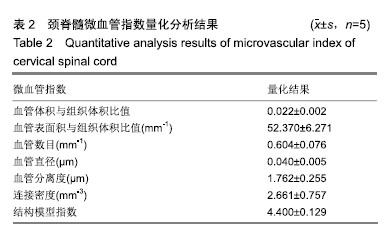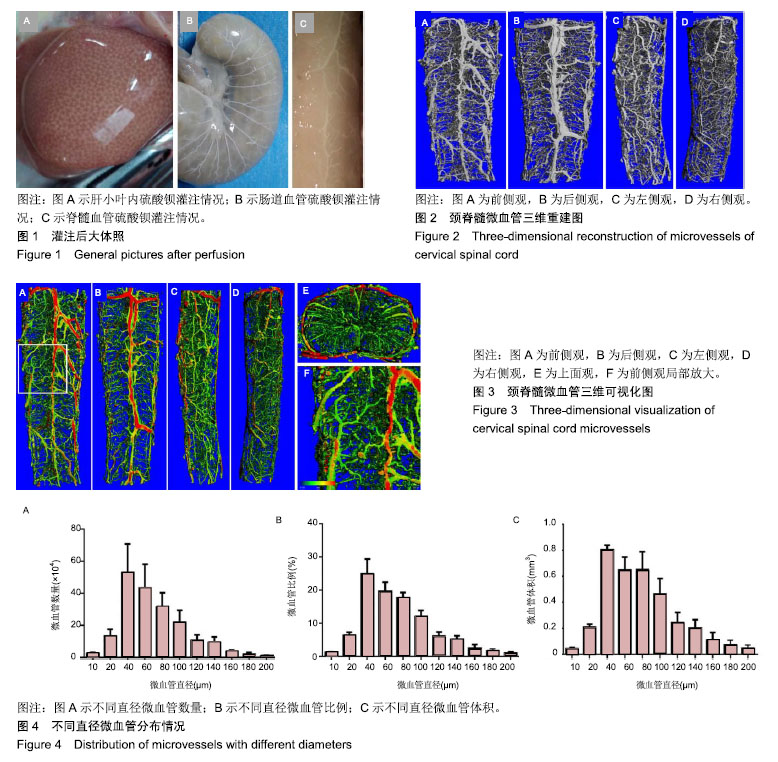| [1]Melissano G, Bertoglio L, Rinaldi E, et al. An anatomical review of spinal cord blood supply. J Cardiovasc Surg. 2015;56(5):699-706.[2]Wu T, Cao Y, Ni S, et al. Morphometric analysis of rat spinal cord angioarchitecture by phase contrast radiography from 2D to 3D visualization. Spine. 2018;43(9):504-511.[3]Ertuerk A, Becker K, Jaehrling N, et al. Three-dimensional imaging of solvent-cleared organs using 3DISCO. Nat Protoc. 2012;7(11):1983-1995.[4]Ni S, Cao Y, Jiang L, et al. Synchrotron radiation imaging reveals the role of estrogen in promoting angiogenesis after acute spinal cord injury in rats. Spine. 2018;43(18):1241-1249.[5]Cao Y, Wu T, Yuan Z, et al. Three-dimensional imaging of microvasculature in the rat spinal cord following injury. Sci Rep. 2015;5:12643.[6]Cheng X, Long H, Chen W, et al. Three-dimensional alteration of cervical anterior spinal artery and anterior radicular artery in rat model of chronic spinal cord compression by micro-CT. Neurosci Lett. 2015; 606:106-112.[7]Long HQ, Xie WH, Chen WL, et al. Value of Micro-CT for monitoring spinal microvascular changes after chronic spinal cord compression. Int J Mol Sci. 2014;15(7):12061-12073.[8]Hu JZ, Wu TD, Zeng L, et al. Visualization of microvasculature by x-ray in-line phase contrast imaging in rat spinal cord. Phys Med Biolo. 2012; 57(5):55-63.[9]Qiu MG, Zhu XH. Aging changes of the angioarchitecture and arterial morphology of the spinal cord in rats. Gerontology. 2004;50(6): 360-365.[10]Xia Q, Feng Y, Yin T, et al. An Imaging and Histological Study on Intrahepatic Microvascular Passage of Contrast Materials in Rat Liver. Biomed Res Int. 2017;2017:1419545.[11]Kingston MJ, Perriman DM, Neeman T, et al. Contrast agent comparison for three-dimensional micro-CT angiography: A cadaveric study. Contrast Media Mol Imaging. 2016;11(4):319-324.[12]Perrien DS, Saleh MA, Takahashi K, et al. Novel methods for microCT-based analyses of vasculature in the renal cortex reveal a loss of perfusable arterioles and glomeruli in eNOS-/- mice. BMC Nephrol. 2016;17:24.[13]Hu J, Cao Y, Wu T, et al. 3D angioarchitecture changes after spinal cord injury in rats using synchrotron radiation phase-contrast tomography. Spinal Cord. 2015;53(8):585-590.[14]Atwood RC, Lee PD, Konerding MA, et al. Quantitation of microcomputed tomography-imaged ocular microvasculature. Microcirculation (New York, NY : 1994). 2010;17(1):59-68.[15]Ghanavati S, Yu LX, Lerch JP, et al. A perfusion procedure for imaging of the mouse cerebral vasculature by X-ray micro-CT. J Neurosci Methods. 2014;221:70-77.[16]Pauwels E, Van Loo D, Cornillie P, et al. An exploratory study of contrast agents for soft tissue visualization by means of high resolution X-ray computed tomography imaging. J Microsc. 2013;250(1):21-31.[17]Pabst AM, Ackermann M, Wagner W, et al. Imaging angiogenesis: perspectives and opportunities in tumour research - a method display. J Craniomaxillofac Surg. 2014;42(6):915-923.[18]Hu JZ, Wu TD, Zhang T, et al. Three-dimensional alteration of microvasculature in a rat model of traumatic spinal cord injury. J Neurosci Methods. 2012;204(1):150-158.[19]Hallouard F, Anton N, Choquet P, et al. Iodinated blood pool contrast media for preclinical X-ray imaging applications--a review. Biomaterials. 2010;31(24):6249-6268.[20]Chien CC, Wang CH, Wang CL, et al. Synchrotron microangiography studies of angiogenesis in mice with microemulsions and gold nanoparticles. Anal Bioanal Chem. 2010;397(6):2109-2116.[21]Long HQ, Xie WH, Chen WL, et al. Value of micro-CT for monitoring spinal microvascular changes after chronic spinal cord compression. Int J Mol Sci. 2014;15(7):12061-12073.[22]Mazensky D, Flesarova S. Arterial blood supply to the spinal cord in animal models of spinal cord injury. Review. 2017;300(12):2091-2106.[23]Fratini M, Bukreeva I, Campi G, et al. Simultaneous submicrometric 3D imaging of the micro-vascular network and the neuronal system in a mouse spinal cord. Sci Rep. 2015;5:8514.[24]Martirosyan NL, Feuerstein JS, Theodore N, et al. Blood supply and vascular reactivity of the spinal cord under normal and pathological conditions. J Neurosurg Spine. 2011;15(3):238-251.[25]Chugh BP, Lerch JP, Yu LX, et al. Measurement of cerebral blood volume in mouse brain regions using micro-computed tomography. NeuroImage. 2009;47(4):1312-1318.[26]Xu HM, Wang YL, Jin HM, et al. A novel micro-CT-based method to monitor the morphology of blood vessels in the rabbit endplate. Eur Spine J. 2017;26(1):221-227.[27]Roche B, David V, Vanden-Bossche A, et al. Structure and quantification of microvascularisation within mouse long bones: what and how should we measure? Bone. 2012;50(1):390-399.[28]Blery P, Pilet P, Bossche AV, et al. Vascular imaging with contrast agent in hard and soft tissues using microcomputed-tomography. J Microsc. 2016;262(1):40-49.[29]Roche B, Vanden-Bossche A, Normand M, et al. Validated Laser Doppler protocol for measurement of mouse bone blood perfusion - response to age or ovariectomy differs with genetic background. Bone. 2013;55(2):418-426.[30]Prisby R, Guignandon A, Vanden-Bossche A, et al. Intermittent PTH(1-84) is osteoanabolic but not osteoangiogenic and relocates bone marrow blood vessels closer to bone-forming sites. J Bone Miner Res. 2011;26(11):2583-2596. |
.jpg)


.jpg)
.jpg)